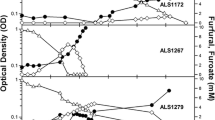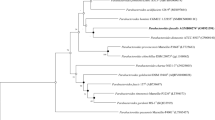Abstract
A gram-negative rod-shaped bacterium capable of utilizing acrylonitrile as the sole source of nitrogen was isolated from industrial sewage and identified as Klebsiella pneumoniae. The isolate was capable of utilizing aliphatic nitriles containing 1 to 5 carbon atoms or benzonitrile as the sole source of nitrogen and either acetamide or propionamide as the sole source of both carbon and nitrogen. Gas chromatographic and mass spectral analyses of culture filtrates indicated that K. pneumoniae was capable of hydrolyzing 6.15 mmol of acrylonitrile to 5.15 mmol of acrylamide within 24 h. The acrylamide was hydrolyzed to 1.0 mmol of acrylic acid within 72 h. Another metabolite of acrylonitrile metabolism was ammonia, which reached a maximum concentration of 3.69 mM within 48 h. Nitrile hydratase and amidase, the two hydrolytic enzymes responsible for the sequential metabolism of nitrile compounds, were induced by acrylonitrile. The optimum temperature for nitrile hydratase activity was 55°C and that for amidase was 40°C; both enzymes had pH optima of 8.0.
Similar content being viewed by others
Abbreviations
- PBM:
-
phosphate buffered medium
- GC:
-
gas chromatography
- GC/MS:
-
gas chromatography/mass spectrometry
References
Asano Y, Fujishiro K, Tani Y, Yamada H (1982a) Aliphatic nitrile hydratase from Arthrobacter sp. J-1. Purification and characterization. Agric Biol Chem 46:1165–1174
Asano Y, Tachibana M, Tani Y, Yamada H (1982b) Purification and characterization of amidase which participates in nitrile degradation. Agric Biol Chem 46:1175–1181
Asano Y, Yamada Y, Tani Y, Yamada H (1982c) A new enzymatic method of acrylamide production. Agric Biol Chem 46:1183–1189
Bui K, Fradet H, Arnaud A, Galzy P (1984) A nitrile hydratase with a wide substrate spectrum produced by a Brevibacterium sp. J Gen Microbiol 130:89–93
Cavins JF, Friedman M (1968) Specific modification of protein sulfhydryl groups with β-unsaturated compounds. J Biol Chem 243:3357–3360
Cherry AB, Gabbacia AF, Senn HW (1956) The assimilation behaviour of certain toxic organic compounds in natural waters. Sewage Ind Wastes 28:1137–1141
DeMeester CF, Poncelet M, Roberfroid M, Mervier M (1978) Mutagenicity of acrylonitrile. Toxicology 11:19–27
DiGeronimo MJ, Antoine AD (1976) Metabolism of acetonitrile and propionitrile by Nocardia rhodochrous LL 1100–21. Appl Environ Microbiol 31:900–906
Enviro Control Inc (1978) Economic impact assessment for acrylonitrile. Contract Report J-9-F-60229. Department of Labor, Occupational Safety and Health Administration, Washington DC
Ewing WH (1986) The genus Klebsiella. In: Edwards PR, Ewing WH (eds) Identification of enterobacteriaceae. Elsevier, New York, pp 367–369
Friedman M, Cairns JF, Wall JS (1965) Relative nucleophilic reactivities of amino groups and mercaptide ions in addition reactions with β-unsaturated compounds. J Am Chem Soc 87: 3672–3682
Igisu H, Goto I, Kawamura Y, Kato M, Izmui K, Kuroiwa Y (1975) Acrylamide encephaloneuropathy due to well water pollution. J Neurol Neurosurg Psychiatr 38:581–584
Kaplan A (1969) The determination of urea, ammonia and urease. Methods Biochem Anal 17:311–324
Keith LH, Telliard WA (1979) Priority pollutants. I. A perspective view. Environ Sci Technol 13:416–423
Kobayashi M, Yanaka N, Nagasawa T, Yamada H (1990) Purification and characterization of a novel nitrilase of Rhodococcus rhodochrous K 22 that acts on aliphatic nitriles. J Bacteriol 172:4807–4815
Lowry OH, Rosebrough NJ, Farr AL, Randall RJ (1951) Protein measurement with the Folin phenol reagent. J Biol Chem 193:265–275
McBride KE, Kenny JW, Stalker DM (1986) Metabolism of the herbicide bromoxynil by Klebsiella pneumoniae subsp. ozaenae. Appl Environ Microbiol 53:325–330
National Institute for Occupational Safety and Health (1977) Current Intelligence Bulletin: acrylonitrile. United States Government Printing Office, Washington, DC
Nawaz MS, Chapatwala KD, Wolfram JH (1989) Degradation of acetonitrile by Pseudomonas putida. Appl Environ Microbiol 55:2267–2274
Nishikawa H, Muto Y, Sonada Y, Miyaki Y (1978) Effects of high molecular coagulants on agricultural crops. Gifu-Ken Kogyo Gijutsu Senta Kenjyu Hokoku (Jpn) 10:5–8
Orusev T, Poporski P (1973) Symptoms of chronic occupational acrylonitrile poisoning. God Zbornik Med Fak Skopje 19:187–192
Ryuno K, Nagasawa T, Yamada H (1988) Isolation of advantageous mutants of Pseudomonas chlororaphis B23 for the enzymatic production of acrylamide. Agric Biol Chem 52:1813–1816
Sakurai H, Kusumoto M (1972) Epidemiological study of health impairment among acrylonitrile workers. J Sci Labor 48:273–282
Tourneix D, Thiery A, Maestracci M, Arnaud A, Galzy P (1986) Nitriles as growth substrates for Brevibacterium sp. R312 and its mutant. Zentralbl Mikrobiol 141:575–582
Watanabe I, Satoh Y, Enomoto K (1987) Screening, isolation and taxonomical properties of microorganisms having acrylonitrile hydrating activity. Agric Biol Chem 51:3193–3199
White JM, Jones DD, Huang D, Gauthier JJ (1988) Conversion of cyanide to formate and ammonia by a pseudomonad obtained from industrial wastewater. J Ind Microbiol 3:263–272
Yamada H, Asano Y, Tani Y (1979) Microbial utilization of acrylonitrile. J Ferment Technol 5:8–14
Yamada H, Asano Y, Hino T, Tani Y (1980) Microbial utilization of glutaronitrile. J Ferment Technol 6:495–500
Author information
Authors and Affiliations
Rights and permissions
About this article
Cite this article
Nawaz, M.S., Franklin, W., Campbell, W.L. et al. Metabolism of acrylonitrile by Klebsiella pneumoniae . Arch. Microbiol. 156, 231–238 (1991). https://doi.org/10.1007/BF00249120
Received:
Accepted:
Published:
Issue Date:
DOI: https://doi.org/10.1007/BF00249120




